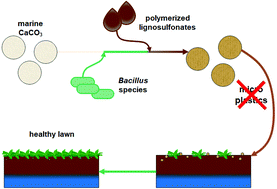A biobased, bioactive, low CO2 impact coating for soil improvers†
Abstract
Lignosulfonate-based bioactive coatings as soil improvers for lawns were developed using laccase as a biocatalyst. Incorporation of glycerol, xylitol and sorbitol as plasticizers considerably reduced the brittleness of the synthesized coatings of marine carbonate granules while thermal enzyme inactivation at 100 °C enabled the production of stable coatings. Heat inactivation produced stable coatings with a molecular weight of 2000 kDa and a viscosity of 4.5 × 10−3 Pas. The desired plasticity for the spray coating of soil improver granules was achieved by the addition of 2.7% of xylitol. Agriculture beneficial microorganisms (four different Bacillus species) were integrated into the coatings. The stable coatings protected the marine calcium carbonate granules, maintained the viability of the microorganisms and showed no toxic effects on the germination and growth of model plants including corn, wheat, salad, and tomato despite a slight delay in germination. Moreover, the coatings reduced the dust formation of soil improvers by 70%. CO2 emission analysis showed potential for the reduction of up to 3.4 kg CO2-eq. kg−1 product, making it a viable alternative to fossil-based coatings.



 Please wait while we load your content...
Please wait while we load your content...